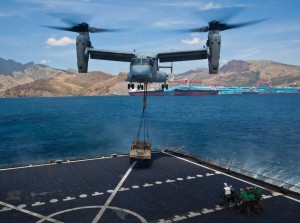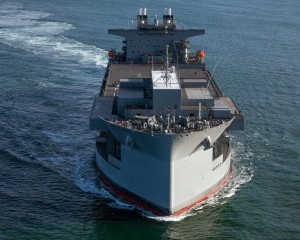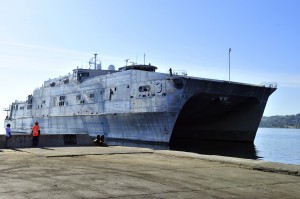2015-08-19 By Robbin Laird
During a visit to Hawaii at the end of July 2015, I had a chance to sit down with two senior Navy personnel who work the MSC aspect for PACFLEET.
CDR Corey Turner and Bruce Stewart are senior personnel with the MSC Detachment PACFLEET and discussed the key role of MSC in PACFLEET and MARFORCPAC operations (as well as the USCG) and provided updates on new platforms, which have entered Pacific operations only this year.
In writing a series on the Pacific for Breaking Defense, a series which presaged my book with Ed Timperlake and Richard Weitz on Pacific defense, I started the series with a look at Military Sealift Command, for sustainable reach is at the heart of effective operations.
Logistics is usually looked at last, and considered the tail of the operation.
But when trying to build a distributed force over an area as large as the Pacific it is much more than that.
The U.S. can afford to build a 21st century power projection force able to provide a lynchpin for Asian security. But it won’t be able to if we don’t take advantage of new concepts of operation, new technologies and new approaches.
A key element for deploying a forward presence force is sustainability. There is probably no subject less discussed in the strategic debates than logistics and sustainment. As a version of the old adage goes: “Amateurs discuss strategy; professionals think logistics.”
This could not be truer when it comes to the Military Sealift Command.
The Military Sealift Command is not the most visible element of the Navy-Marine Corps team, unless you are at sea and need them.
Whether that support comes from underway replenishment, from ships at sea or air assets, the more than 100 MSC ships are the lifeblood of our fleet.
We started the discussion with a base line point: the MSC fleet in the Pacific represents 33.16% of the entire PACFLEET inventory. One trend line has been tapping into MSC to supplement some of the operations of the L-class ships, but clearly MSC hulls and crews are not the same as L-class ships and crews.
There are cases where in a crisis or in a high demand situation, a T-AKE ship has replaced an L-class for the mission. This clearly is in response as well to shortfall in L-class ships. It is also the case that the T-AKE ship is a high demand asset as well in the Pacific.

A major shift is underway as well with the Navy and Marine Corps looking to distribute forces over the Pacific, a term which some Navy leadership refers to as distributed lethality.
This changes how the MSC fleet needs to operate.
“We are shifting from a hub and spoke delivery system, skin to skin, and to an afloat support approach whereby support ships can offload to a variety of MSC ships to support the gray hulls on deployment.”
With the emergence of an Afloat basing approach, the MSC fleet is adjusting the relationship among its deployed assets as it in turn supports a more dispersed and disturbed combat fleet. In effect, there is a double transition underway in the Pacific.
“Given the tyranny of the Pacific, this shift is challenging.
But the MSC is a crucial fleet enabler providing a wide body of services to the deployed force It operates as a force multiplier, notably for a distributed fleet.”
This year, the Montford Point and the Joint High Speed Vessel have both come to the Pacific, and the two interviewees provided an update on their first impressions.
With regard to the Montford Point, it is designed to be assigned to the pre-positioning fleet and will provide a viable alternative to landing supplies and equipment directly to a port. The Montford Point can help tansitiion those supplies and equipment directory to shore. There are sea-state limitations to the ship which will affect how it is used.
And the important addition of a module air support capability on the ship will be an important increase in capability as well.
As Admiral Buzby, then head of the MSC, put it in an interview in 2013:
Admiral Buzby: With the MLP-Afloat Forward Staging Base (MLP-AFSB) or AFSB variant of the ship, you are seeing the versatility built into the ship.
The main capability of the ship is its versatility.
The AFSB will be the latest incarnation of what one can fit into that 800 feet of empty space that fills a need, fills a requirement without having to go out and purpose build at great expense, and at great length of design, a capability to serve the war fighter.
With the AFSB, you will see a fairly robust aviation capability; a fairly robust boat capability to support a whole host of different missions. I think it’s a very strong, and very positive step forward in this ship’s future.
You could very easily, given the dimensions that we are currently envisioning in the design of AFSB, hanger space, deck space, we’re designing it on the big side for CH-53s and that kind of asset.
But you could conceivably have an ACE aboard that ship, supporting a reinforced MEU or something like that because you could probably carry Cobras on it, UAVs, and could envisage putting some joint strike fighters on there in small numbers if you really needed to, or MV 22s. One could be very creative in mixing the aviation assets on that ship.
https://sldinfo.com/admiral-buzby-on-the-evolving-capabilities-of-a-usn-usmc-msc-enabled-fleet/

This June the first AFSB variant has been delivered to the US Navy,
The first General Dynamics NASSCO built Afloat Forward Staging Base (AFSB) delivered to the U.S. Navy on Friday, Naval Sea Systems Command said.
USNS Lewis B. Puller (MLP-3/AFSB) — based on an Alaska-class commercial crude carrier — is designed to host special operations forces (SOF) and mine countermeasure (MCM) helicopters as part of the Navy, U.S. Military Sea Lift Command and the Marines push to more capability for amphibious forces and capacity for seabasing with less expensive ships.
“This ship represents a leap forward in flexible capability for the U.S. Navy,” said Capt. Henry Stevens, Strategic and Theater Sealift program manager in Program Executive Office, Ships said in a statement.“NASSCO was able to leverage a mature design and hot production line to meet the Navy’s requirements for an AFSB platform while minimizing program cost and risk.”
The ship is the third based on the Alaska-class following two MSC Mobile Landing Platforms — USNS Montford Point and USNS John Glenn
For the interviewees, the new variant of the Montford Point “will enhance the ability of the ship to support autonomous operations with deployed forces.”
Give the transition to a distributed operational template, such a capability will be even more important than in a traditional MSC support role.
The Joint High Speed Vessel (JHSV) has been in the Pacific for about three months, and they find the ship a useful at sea truck to support a diversity of tasks, in which an at sea truck is useful.
One example was the use of the ship to move an air wing around Japan by sea rather than doing so by land using trucks.
The modularity built into the JHSV, and its speed make it a useful support ship and notably in helping support low end missions with which the fleet is tasked.

When asked what they thought are the short list of needs for the MSC fleet beyond the question of numbers of platforms, they suggested two.
The first was the need to modify the gray hulls and the MSC fleet to have more effective ways to transfer assets from the MSC ships to the Gray Hulls. We saw earlier that this is a challenge for the F-35 engine, but it is a broader problem.
One issue, which they highlighted, was the challenge of transferring weapons going forward from MSC ships to the gray hulls, and obviously crucial need going forward.
The second was the impact of the decline of the US merchant marine due to global shipping trends.
“With the dearth and aging of US mariners, where are we going to get the people to work on the MSC fleet? This is a national problem; not just one facing MSC.”
For our interviews with the current and recent heads of the Military Sealift Command, see the following:
https://sldinfo.com/admiral-shannon-discusses-the-evolving-roles-of-the-military-sealift-command/
https://sldinfo.com/admiral-buzby-on-the-evolving-capabilities-of-a-usn-usmc-msc-enabled-fleet/
https://sldinfo.com/anticipating-the-usns-montford-point-an-interview-with-admiral-buzby/
Also see the interview with the builder of the Montford Point:
https://sldinfo.com/building-a-new-ship-fred-harris-discusses-the-mobile-landing-platform/

